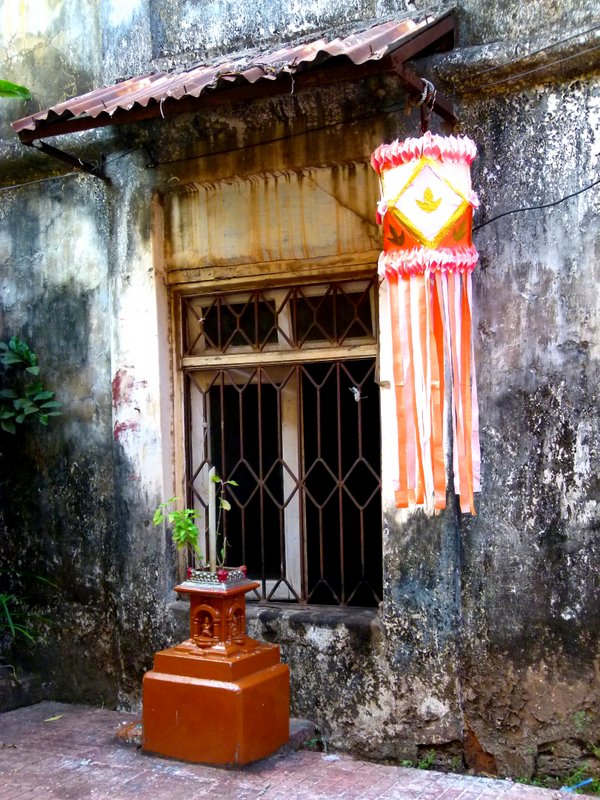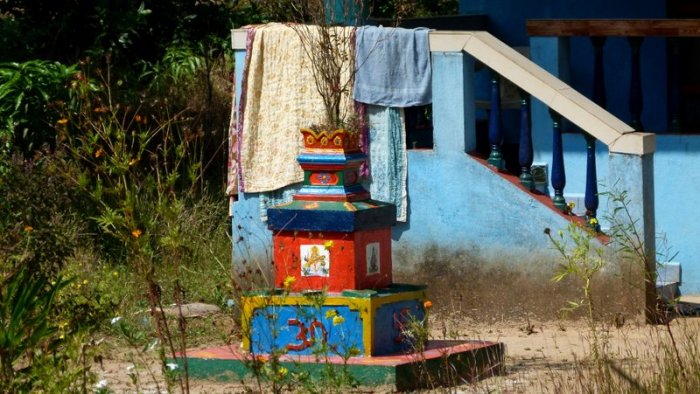As per Hindu tradition, a house without a tulsi or sacred basil plant is considered to be incomplete. The tulsi, one of India’s sacred plants with rich mythological and religious associations, is usually planted near the entrance to the house in specially made planters known as tulsi vrindavans.
Cities, highrises and tulsi vrindavans have an uneasy relationship and cannot really coexist well together. As a result, it’s rare to see tulsi vrindavans in cities like Mumbai; in smaller towns and rural India, however its a different story and I’ve seen them in my various travels in India.

I couldn’t have been more wrong. As it happened I saw quite a lot of them !
On my very first evening in Goa, I lost count of the the number of tulsi vrindavans I came across I walked from the service apartment I was staying in at Colva to the Colva beach for dinner. Though I didn’t know at that time, it was tulsi vivaah that day and the atmosphere was quite festive. The tulsi vrindavans were gaily decorated and families were gathered around it for the puja. Oil lamps and kandeels (lanterns) added to the soft golden glow that surrounded the tulsi vrindavans. It was a beautiful sight.
Over the next few days that I was in Goa, I saw them everywhere. Driving from West to East Goa, in Catholic-dominated Fontinhas, at Aldona, inside Bhagwan Mahaveer Wildlife Sanctuary, in Colva… they were everywhere and made from a variety of materials as well.






I returned to Mumbai with the idea that I would write a post on the tulsi vrindavans in Goa as part of my Travel Shot series. But then I came across the following in the last few months:
- A book with a very intriguing title, The Tulsi and the Cross: Anthropology and the Colonial Encounter in Goa by Rosa Maria Perez. I bought it recently and though I have not finished reading it, I can share the gist of the author’s ethnographical research which shows that Goa is, and was, dominantly Hindu and the perception of Goan society as Catholic is a colonial imposition that continues to be perpetuated today.
- This newspaper article, titled “Portuguese Dilemma” by Joseph Zuzarte. The article talks about, among other things, Catholic old timers harking for the Goan (read Portuguese) way of life and Goan Hindus wishing to banish everything and anything that is a reminder of Portuguese oppression.
- A book on Christian Themes in Indian Art, where I came across the state-wise percentage of Christians in India. Goa’s was just 30%.
Each of the readings left me thinking about more and then some more about culture and identity in the context of Goa leaving me intrigued and perplexed at the same time. While I was aware that Goa had a significant Hindu population, I had not realised just how “significant” the number and spread was. If one goes by popular perception of Goa, it is dominantly and almost overwhelmingly Catholic. Anything that does not fit in is either ignored or labelled as offbeat.
 Even the media seems to have taken this stand. While at Goa I was surprised to find just how little mention there was of the tulsi vivaah in the Goan newspapers. Instead, they were full of reports of All Souls Day, which had just got over or articles on ancestral visits (of Goans who had migrated to Portugal) apart from local political news.
Even the media seems to have taken this stand. While at Goa I was surprised to find just how little mention there was of the tulsi vivaah in the Goan newspapers. Instead, they were full of reports of All Souls Day, which had just got over or articles on ancestral visits (of Goans who had migrated to Portugal) apart from local political news.
Tulsi vivaah is an important festival for Hindus, as it marks the beginning of the marriage season. For Goan Hindus, it goes beyond that and is no less than an ancestral visit.
Fellow blogger Mukta (who is from Goa) had this to say about tulsi vivaah over an interaction on Twitter:
… My family does celebrate it. I’ve missed it by a narrow margin a few times but have seen the excitement. The extended family comes together to celebrate and eat etc… In Goa, families are still very close knit so everything becomes a community thing.
It is tulsi vivaah today and families must have gathered from all over at Goa for the ceremony which begins late at night. The tulsi vrindavans would have received a fresh coat of paint and would have been decked with flowers like a bride. Special delicacies befitting a wedding feast would have been prepared. The lamps and kandeels would have been lit adding to the festive spirit.
Sometimes, it takes a while to understand or comprehend what you have seen or observed or experienced. And when that happens as part of a travel experience, you just want to go back again.
I wish I was there in Goa right now participating in the tulsi vivaah festivities. 🙂

You have captured so many Tulsi vrindavans 😀 I din’t know that Goa is also full of such traditions “Sometimes, it takes a while to understand or comprehend what you have seen or observed or experienced. And when that happens as part of a travel experience, you just want to go back again.” This line will stay with me 🙂 Because I feel the same for many things.
LikeLiked by 1 person
Goa was a bit of a surprise package and the tulsi vrindavans were just one of them. There’s a lot I saw which I’m still trying to figure out. Maybe I’ll write about it, maybe not. Or maybe I’ll just go back to visit the same places again. 🙂
LikeLike
beautiful post, Sudha!! i have never seen such a variety of Tulsi Brindavans before! will definitely watch out for more whenever i go somewhere next
LikeLiked by 1 person
Me too. The first time I noticed tulsi vrindavans was on a bus trip from Udipi to Srigeri via the Agumbe Ghats. After a point, i just stopped counting. Most of them were simple mud structures, but with elaborate kolams around them. Goa was the second place I saw them.
LikeLike
Really wonderful post! You very rightly mentioned about the ‘offbeat’ part…! 🙂
LikeLiked by 1 person
Thanks, Jatin. I think “offbeat” is the most abused word in travel writing parlance. Most people who use the word fail to realise that what is offbeat for them, may be mainstream for someone else and vice versa. 🙂
LikeLiked by 1 person
Great Post Sudha 🙂
LikeLiked by 1 person
Thanks, Coolpalms. 🙂
LikeLiked by 1 person
I loved the caked mud tulsi vrindavans the best, not that I didn’t like the others too. As for perpetuating stereotypes, our media takes the cake, wine and everything else besides. So much so that even travelers end up looking only for the Christian and Portuguese art and architecture. the demographical break up is a revelation.
I have seen tulsi vivah being celebrated elaborately in Jabalpur temples. There is the bride and the groom’s parties and it is complete in all respects — baraatis and all. The bride tulsi is ‘given away’ in kanyadaan and there is bidai… the works. Wonder how they celebrate it in Goa in homes. Dr.Google should help 🙂
LikeLiked by 1 person
I loved the account of tulsi vivaah in Jabalpur and I hope I can see it one day. Google Uncle or rather some blog posts say that Tulsi Vivaah is a very special time for Goan Hindus. Sweets and wicks to light the lamp for Tulsi Vivaah are sent to the homes of married daughters. In some families, it is the time for the extended families to gather and celebrate the wedding. There is a special wedding feast and all that
It is not just the media, Zephyr. Even travel writers and travel bloggers don’t talk or write about this. If they do write of something away from the popular perception, it is still something that is either being promoted by the state tourism. For example the Sao Joao or Shigmo Festivals in Goa which are promoted as offbeat reasons for visiting Goa.
I have always maintained that it is not the place or event that is offbeat or unique. It is the participant observer’s perception that is unique. 🙂
LikeLike
Every Hindu home in Udupi/Mangalore has the tulsi vrindavan. While some are elaborate, many are simple mud coated with cow-dung structures. May be you can make another trip there and write a post about them.
As you rightly mentioned, ‘goa tourism’ is all about Christian dominated lifestyle, architecture, churches, carnivals and so on.
LikeLike
It seems that the place is so peaceful. I wish to stay there away from the crowd. The place is really nice. Thank u for sharing the article. keep posting with lots more.
LikeLike
Hi Shreya, thank you so much for stopping by and commenting and for your appreciation too. 🙂
LikeLike
I’m reading this at an opportune time. I recently got a tulsi plant from the local temple and I’m trying my best to keep it alive. I have been unsuccessful in the past and am hoping this time it’ll be different. However, my tulsi vrindavan is a tiny red pot and sadly, that’s how it shall stay. The weather here will not permit me an elaborate Tulsi vrindavan like the one in my paatis’ houses 😦
LikeLike
Good luck with keeping the tulsi plant alive 🙂
LikeLike
We went to Goa this June. It is a very beautiful place. We were in Goa for a couple of weeks. Thanks for sharing such unique information about Goa. The Tulsi plant play a very important part in Hindu traditions. I had a great time reading this post it is really interesting and informative.
LikeLike
My heart is so happy to see your loving words about Tulsi lagna in my motherland. I pray that Bhagwan Vishnu and Ma Tulsi bless you abundantly. We Hindus in Goa may have been sidelined by the press, but for the real devotee, Bhagwan knows how to lead him/her to His servants. Mangalam, mangalam Bhagwan Vishnu. Jai Ma. 🙏
LikeLike